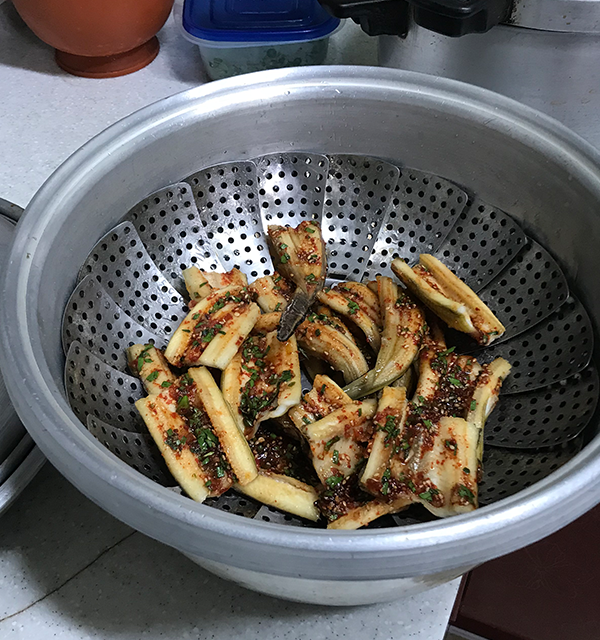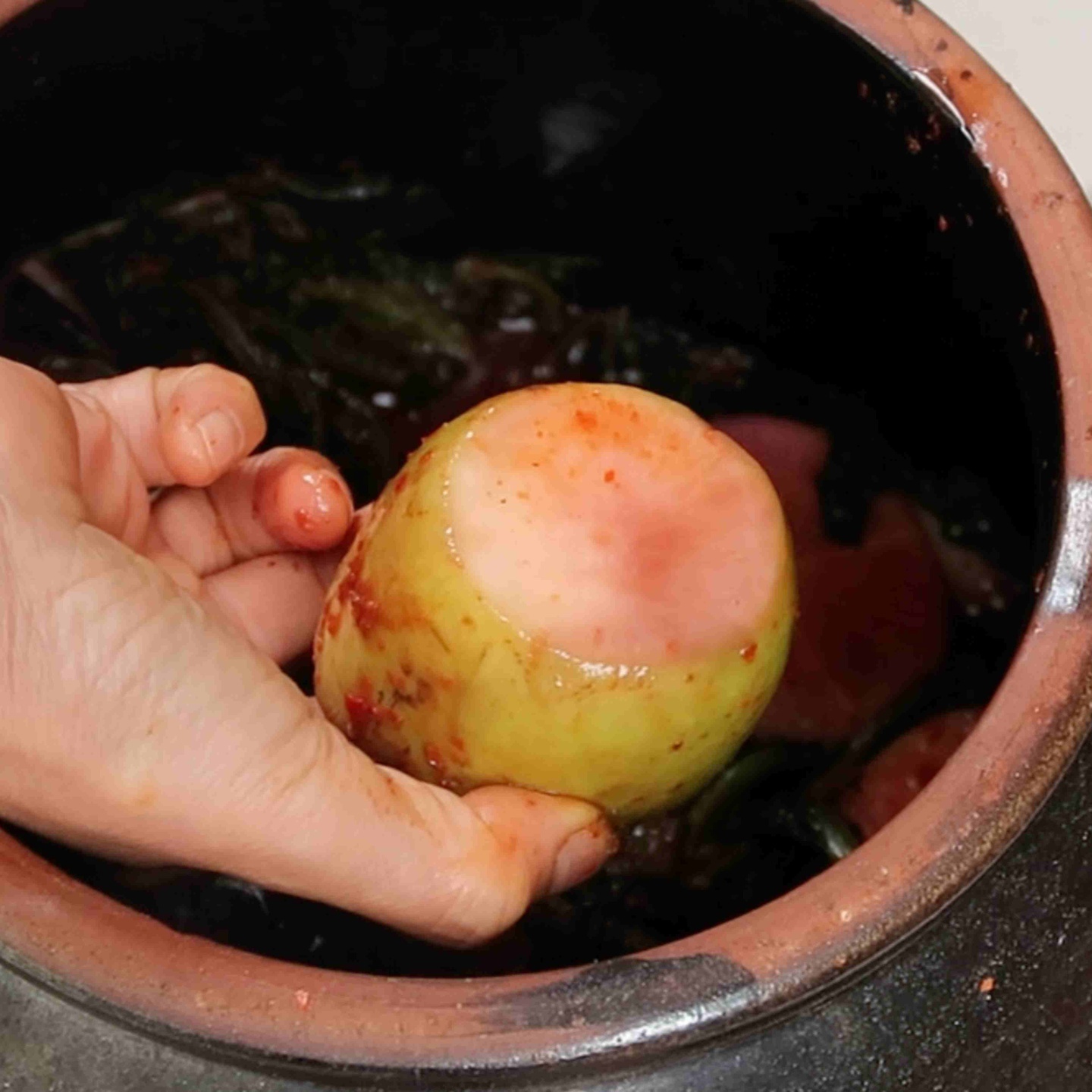What is a Ttukbaegi?
A Ttukbaegi is a ceramic pot that retains heat well. It can be used for making and serving soups or when making steamed eggs. Ttukbaegi (뚝배기) is available in different sizes and depths and so you will need to adjust your steamed egg recipe based on the size of your Ttukbaegi.
The most common thing to steam in this vessel are steamed eggs. The basic way a Ttukbaegi is used for steaming eggs is by placing all the ingredients into the Ttukbaegi and then covering it with a lid so that the steam is trapped and the egg mixture inside is completely cooked by the steam.
There are different kinds of steamed eggs in Korean cuisine using different vessels, but I will be focusing on how to make steamed eggs using a Ttukbaegi.
So, the Ttukbaegi can be broken down into two parts: the bowl and the lid. A key point we would like to achieve when making steamed eggs using a Ttukbaegi is some height. Steamed eggs look super appetizing when it has risen above the pot.
To achieve this height, we need to talk about the lid that you can use on a Ttukbaegi. If you use the lid that the Ttukbaegi comes with it, then that flatter lid can stop the egg from rising high in the Ttukbaegi.
If you want to get that height, then you can use another Ttukbaegi as a lid. Just place it on top of your Ttukbaegi which contains the egg mixture. Using a “lid” with space inside of it can allow the egg mixture to rise while still keeping the steam and heat inside of the vessel. If you do not have another Ttukbaegi, then do not use a glass or plastic bowl because it can shatter or melt. If you cannot find a heat-safe bowl or another Ttukbaegi, then just use the lid that came with the Ttukbaegi because, in the end, trapping the steam inside of the Ttukbaegi is more important than achieving an appetizing height.
What We Want to Achieve When Making Steamed Eggs (계람찜)
There are some aspects of this steamed dish that we want to achieve to make delicious steamed eggs.
- We want the egg mixture inside the Ttukbaegi to be fully cooked without being burnt.
- We want the egg to be fluffy and light in texture. There are other kinds of “steamed eggs” that are more like pudding in texture, but we want a fluffy texture when using a Ttukbaegi.
- The liquid egg mixture should be seasoned before it is steamed. We will not add any seasoning as it cooks or after it is done steaming. For example, you would not usually sprinkle salt on top of the steamed egg once it is done steaming.
- You want the steamed egg to have some height. Getting the egg to have some height can be tricky, but it makes this dish more appetizing. As I talked about, using another Ttukbaegi on top can let that egg rise higher.
- This is optional but we can also garnish the steamed egg after it is done with some green onion, cheese, sesame oil, etc. I will go over how you can customize your steamed eggs to your preference in a minute.
- Finally, you need to serve this dish immediately after it is done cooking. It tastes best when it’s hot and the egg has not deflated.
Steamed Eggs (계람찜) Cooking Tips
There are different ways to make steamed eggs using a Ttukbaegi but through my testing, I think this is the most effective version to achieve what I listed above.
Egg Mixture & Basics
Steamed eggs are made with a mixture of broth and eggs. If you only whisked up eggs and added them to the pot, it would most likely burn. You need to add a liquid to the whisked eggs. When you prep your eggs, you need to make sure you mix them completely. The egg mixture should be a uniform color. If you under whisk your egg mixture and leave some unmixed egg whites, it won’t cook properly.
The liquid you use can be broth, water, or rice water. As you know, using broth will give a nice flavor. If you want to make a quick broth, add beef dashida (소고기 다시다) to water and use that for the steamed egg liquid.
Steamed eggs are versatile with the seasoning that you can add. You can add what you like based on your preference, some examples are garlic, chives, green onion, carrot, ham, crab, or onion.
The most basic/classic version of steamed eggs contains egg, liquid, salt, salted shrimp, and green onion, but again you have options.
Steamed Egg Cooking Process
Filling your Ttukbaegi
The first thing I want to talk about is how full your Ttukbaegi should be. When it comes to how full, I am not talking about how much of just the broth is added, I am talking about how full your pot is after you add the broth and the egg.
How full your Ttukbaegi is will determine how tall it will rise. A general rule of thumb is to fill the pot to 80%. You can do this and get a decently high steamed egg. If you want a really tall, steamed egg you can fill it to about 90%. Keep in mind that filling it more can cause some of the egg mixture to overflow slightly as it steams. Overflow will happen a little no matter if you fill it to 80% or 90%. But if it’s very full obviously you will have even more overflow.
Remember we will place a heat-safe bowl or another Ttukbaegi on top of this steamed egg. The space in between will allow the egg to rise very high.
Cooking Steps
Based on my experiments. It is better to add the broth into the Ttukbaegi and bring it to a boil, then add the whisked egg to the broth inside the Ttukbaegi and mix it together.
When you mix, ensure you are hitting the edges of the Ttukbaegi. Do not over-mix or mix the egg mixture the entire time it steams. If you over-mix the egg mixture, it will end up like scrambled eggs and it will not rise.
So, at the beginning of the cooking process mix the egg mixture occasionally with a spoon, and watch it rise. Steamed eggs are the kind of dish you want to watch as it cooks do not walk away in the beginning. After it starts to rise naturally OR once it is about 80% of the way cooked, use a spoon and smooth out the top of the egg and then turn the heat to medium-low and add your lid.
If you smell some burning egg smell, do not worry, that will happen as the egg mixture overflows slightly and drips.
Now let the steamed egg steam for about 4-5 minutes.
After about 5 minutes, take off the lid and garnish if you want with green onion, red pepper flakes, fish eggs (명난), sesame seeds, or sesame oil.
Serve this dish immediately. It will deflate over time and it is best eaten when eaten and served hot.
Seasoning Ingredients for Steamed Eggs (계람찜)
Earlier I mentioned how the basic/classic seasoning for steamed eggs is usually a liquid + eggs + salt + salted shrimp + green onion. You can make it this way, but you also have some options and substitutes that you can use to make it customized to your taste preference.
- Salt (꽃소금): Using salt to season your steamed eggs adds a clean flavor that enhances the flavors of the egg and liquid without changing it or the color.
- Dark Soy Sauce (진간장/왜간장): Dark soy sauce can be used to add a deeper flavor to the steamed eggs.
- Salted Shrimp (새우젓): Salted shrimp adds a salty, savory flavor and pairs well with steamed eggs. Adding salted shrimp can also make the egg softer in texture.
- Fish Sauce (멸치액젓): You can use fish sauce to get a deeper umami flavor without changing the color of the egg mixture. Fish sauce will also add some salt to your steamed eggs.
- Sugar (설탕): Sugar creates a balanced flavor. You can substitute the “salt ingredient” in your steamed eggs for any of the ones I mentioned (salt, soy sauce, fish sauce, etc.), but make sure you add a little sugar to balance the taste of the steamed egg.
- Soybean paste (된장): Soybean paste can add a deeper, savory, salty flavor to your steamed eggs.
- Red Pepper Flakes (고추가루): Red pepper flakes can be added to the egg mixture to add color and spice.


